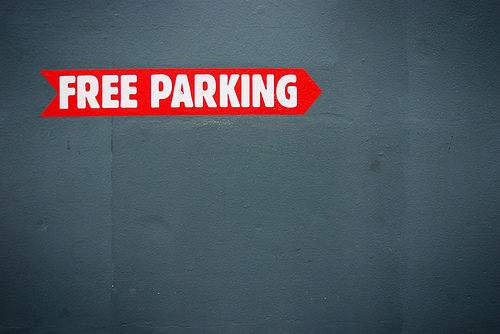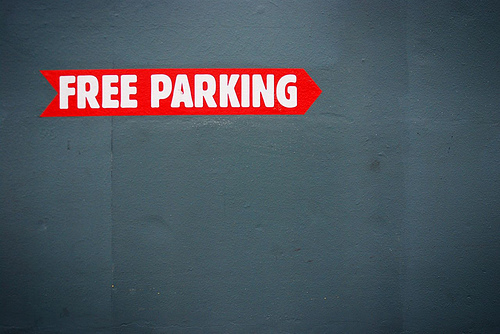Cross posted with permission from UrbDeZine San Francisco.
The Problem
Few ideas turned ubiquitous and entrenched public policy have done more harm to our urban centers than municipal codes requiring minimum off-street parking spaces for all building projects. Donald Shoup, in his book The High Cost of Free Parking, calls this policy a “great planning disaster.” This practice has led to the destruction of massive numbers of historic buildings in order to create parking lots. It has made many remaining historic buildings economically irrelevant by not allowing the uses of those buildings to change without adding prohibitively expensive parking. It has eviscerated our historic central business districts which were designed to be pedestrian-friendly, undermining their economic vitality and cultural integrity. It has forced the creation of new urban centers void of beauty and human scale and has rendered vast urban areas, both new and old, ugly and undesirable places to live and work.
To exacerbate the issue, most required parking must legally be provided for “free.” Parking is “free” with our apartment or “free” when we shop at the mall. Drivers can park throughout this country without paying directly for parking. Unfortunately, all this “free” parking externalizes and masks the true cost of parking and thus the true cost of owning and operating a car. Externalizing the cost of any good drives up the demand for that good and this is the case with owning, driving, and parking cars. Requiring free off-street parking is killing our cities by inducing demand for more cars and more places to store those cars. When you store cars in urban areas, you create ugly, gaping holes in the street level fabric, take away places for people and commerce, and make our cities unattractive and unsafe.

Of course, as Dr. Shoup points out, the inconvenient truth about free parking is that parking is not free. Not even close. In fact, it is incredibly expensive to build and maintain parking, especially in our dense urban centers. The truth is that drivers and non-drivers pay for parking indirectly in higher costs of everything else.
One of the sad victims of this policy is affordable housing. Due to minimum parking requirements, it is impossible to build affordable housing in urban centers without government subsidies because off-street parking must be built for housing projects even if it is a project that targets a low-income demographic that does not drive. With government subsidies and redevelopment monies being phased out, this issue gets worse. Requiring off-street parking for residential projects in urban areas kills affordability.
Then there is the problem of on-street parking. There never seems to be enough of it and we spend ridiculous amounts of time and gas cruising around looking for it, especially in urban centers, creating congestion and lots of stress for drivers and non-drivers alike.
Of course, problems of cars in cities are not all caused by poor planning. Even if municipal leaders wanted to change these policies – and many do – changes meet fear and resistance at planning commission and city council meetings. Drivers' expectations for free parking are now solidly locked in. We drivers expect parking to be free as if it were a civil right; we resent paying for it, and we resent spending excess gas and time looking for it. As neighbors, we fear any decrease by developers in meeting off-street parking minimums. We often hold up projects that actually meet these minimums for fear that they will create spillover and decrease parking spaces where we live. As small business owners, we often fear new projects will take up parking for our customers' use and decrease business. By insisting developers provide the minimum and often beyond the minimum required “free” off-street parking, drivers, neighbors, and small business owners are unwittingly insisting on policies that undermine the economic vitality, affordability, safety, and environmental quality of our urban centers. This leads to a vicious circle that incentivizes the use of more cars, which demands, in turn, more parking, doing further damage to the economic and cultural vitality of our cities.

The Solution
Fortunately, Dr. Shoup also provides us with three simple remedies to these problems:
- Charge the right price for parking. This idea is the kingpin of solving all parking problems. It makes the driver pay the direct cost of parking his or her vehicle, effectively ending the veil we have over the true cost of driving and parking our cars. It naturally incentivizes the use of public transit, bikes, walking, and other less costly means of getting around. It increases availability of parking in commercial areas which has a positive impact on street-level businesses. It provides the solution for the concern about parking spillover into our neighborhoods from new developments by charging people to park in our neighborhoods at a level which ensures the right amount of vacancies for residents. It allows the market to set the right amount of parking spaces by letting the marketplace determine the real demand for parking rather than inducing the demand by providing parking for free. Charging the right price for parking allows developers to meet the real market demand for parking in the most efficient and least costly means possible. Most importantly, it leads to a natural attrition of the single-occupant automobile in our urban centers making them safer and more appealing, thereby restoring them to healthy places for people to live and work.
- Use the income from on-street parking increases to pay for local neighborhood improvements. Voters will support being charged for parking if it provides them quality of life benefits. This is done by the formation of Parking Benefit Districts where municipalities manage the income from parking meters in specific neighborhoods to ensure it is used to fix sidewalks, plant street trees, build or improve bike lanes, build or improve parks, etc.
- Eliminate all minimum off-street parking requirements. Fortunately the first two solutions pave the way for the third by effectively regulating on-street parking availability in our commercial areas and neighborhoods. When we eliminate minimum off-street parking requirements, we allow for the market to set the number of spaces the developer puts in his or her projects. We then naturally incentivize the developer to come up with creative, cost efficient, and affordable ways to provide transit and mobility to residents without the need for cars. In our dense urban centers and Transit Oriented Districts, we can then utilize more of our street-level commercial space for retailers who provide wanted and needed goods and services, returning our downtowns to the people-friendly places of bustling economic and cultural activity they were in the pre-automobile era.

In the latest paperback edition of The High Cost of Free Parking, Dr. Shoup updates the increasing number of places these ideas are taking root and the positive results these ideas are already having. In the Bay Area, San Francisco is leading the way by reducing and eliminating off-street parking requirements. San Francisco has also implemented a market-responsive, pay-for-parking system called SF Park. In what is called “performance parking,” the new parking meters (called Smart Meters) can charge more or less depending on parking vacancies per block and the price can be set by remote control. The goal of the program is to charge the right price for parking, one which maintains a 15 percent vacancy rate at each block so there is always an open parking space close to your destination. If vacancies run below 15 percent, the price for parking in that block is increased. If vacancies are higher, the parking rate is reduced.
As a frequent visitor to San Francisco for business, I find the results wonderful. Where smart meters are installed, I can find a space on the same block as my destination and don’t need to plan for the extra 15 minutes to cruise to find a space. I am willing to pay the increased price to park this way and I am happy to know that this income is going to neighborhood improvements which directly enhance my experience of being there as a pedestrian; drivers pay the right price to park and everyone wins.
Unfortunately, many cities are not pursuing – nor are they benefiting from – these solutions. It is too often an uphill climb for developers and designers to try and bring forth projects with less than minimum required off-street parking spaces even when we can create other means of mobility for our residents and tenants and demonstrate that these spaces are clearly not needed. To remedy this issue, designers, developers, property owners, and all of us who live in, work in, and care about our cities, need to educate ourselves and our planners and city officials about these problems and solutions.

Here are some suggestions and resources for getting started:
- Post this blog on your Facebook page and e-mail to friends and the municipal leaders you know.
- Go to www.sfpark.org to find more about what San Francisco is doing with regard to their performance parking initiative.
- Download and read the following article by Dr. Shoup from Access Magazine. It is an easy read and lays out the issues extremely well. Once you read it, post it on your Facebook page and otherwise get the word out to others: https://www.uctc.net/access/38/access38_free_parking_markets.pdf. Key fact from the article: sixteen studies conducted between 1927 and 2001 found that, on average, 30 percent of the cars in congested downtown traffic were cruising for parking.
- Buy or borrow and read the paperback edition of The High Cost of Free Parking. After reading the book, share it with others, especially planners and city officials like the members of your city planning commission and city council.
- After you read the book you become eligible to join Dr. Shoup’s Facebook page called the Shoupistas where he posts fascinating articles about progress adoption of his ideas and other informative articles about related topics.
- Become politically active on these topics by participating in your local planning commission and city council meetings, especially when local parking issues are being addressed.
- Now that you are in a rare group of parking experts, continue to observe all things related to parking in your area and write about these issues in your local papers, blogs, etc.
- Have a good time. You will see just how much fun you can have with parking!
***
Notes and credits for photographs, top to bottom:
- Massive parking garage built to meet required parking for office building in Oakland, California. You can see two historic brick structures on either side of this garage. Clearly, this is a case where beautiful historic buildings were destroyed to make way for this behemoth. The brick-faced structure in the foreground is abandoned as Oakland’s commercial office market in this area is weak. This building would be a perfect candidate for housing because it is 200 feet from BART, the Bay Areas renowned transit system; but it can not change use under current code without adding cost-prohibitive parking. With the adoption of Dr. Shoup’s solutions, a building like this could be restored to accommodate a mix of housing and street level retail and, once again, become the kind of project that makes for a beautiful and friendly street scape. Photo Credit: Todd Jersey, AIA
- Free Parking Sign. Photo by Brittney Bush. FlickCreative Commons
- Massive commuter parking garage near county offices in Oakland, California. Other than being visual blight and a cultural wasteland, the area around this garage becomes a dangerous ghost town at night because it lost most of its housing and street level retail, and therefore lost the required “eyes on the street” needed to make it safe. Photo Credit: Todd Jersey, AIA
- Photo of sfpark’s Smart Meter. Photo Credit: Egor Lavrov (elavrov). Flickr Creative Commons
##
Related articles on UrbDeZine San Francisco:









